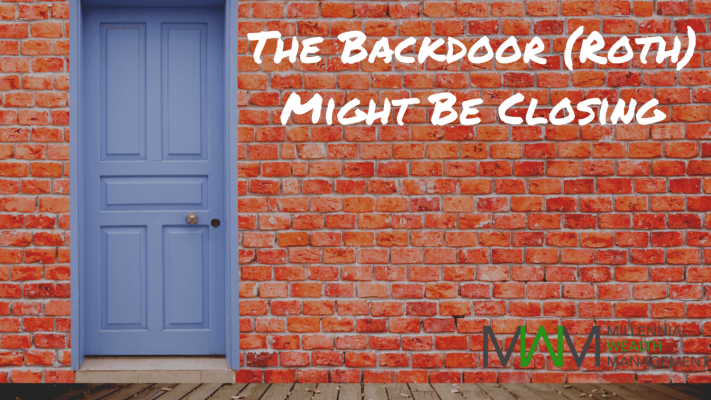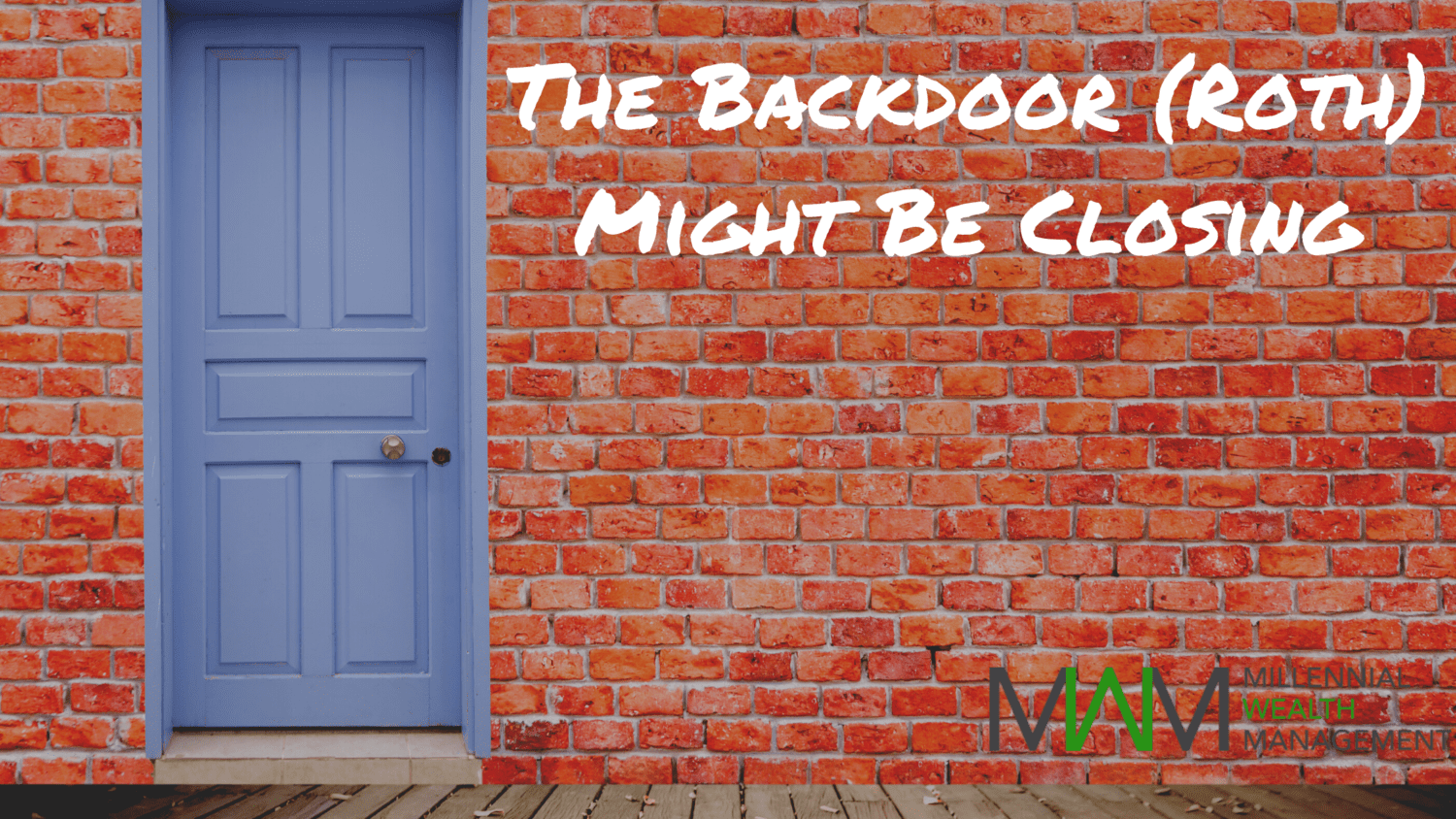The Backdoor (Roth) Might Be Closing
The Roth IRA can be a great way to hedge against rising taxes in retirement. One of the best aspects of a Roth IRA (or Roth money set aside in a 401(k) or other employer sponsored retirement plan) is that the distributions are completely tax-free in retirement as long as certain requirements are met.
You must have earned income for that tax year in order to be eligible to make a Roth IRA contribution, such as paychecks as a W2 employee or self-employment income. Other types of income such as dividends from investments or alimony do not count, so it’s important to confirm you are eligible based on your individual situation.
Roth IRA contributions, unlike traditional IRA contributions, are not tax deductible, meaning there is no tax deduction for that calendar year.
However, the massive benefit of having money set aside in a Roth IRA is that the money that comes out of the account is completely tax-free as long as you take a qualified distribution after age 59.5 and you have first contributed to a Roth IRA at least 5 tax years prior.
This means potentially decades long investment growth on the investments within your Roth IRA come out of the account in retirement completely tax free as long as you take a qualified distribution after age 59.5
Now, you can always take your contributions or basis out tax-free with no penalties or tax.
However, the rules are more restrictive when it comes to withdrawing any earnings portion from the Roth IRA. You may choose to take money out of a Roth IRA prior to age 59.5 but the portion of earnings that comes out of your account will likely be subject to a 10% early withdrawal penalty and taxed as ordinary income.
Simply having the ability to contribute to a Roth IRA or Roth 401(k) offers a massive benefit in itself, but the well known backdoor Roth and mega backdoor Roth strategies have been a favorite of those trying to sock away as much money as possible into Roth as a hedge against future tax rates.
First, a quick primer on the backdoor Roth IRA and mega backdoor Roth.
The (Current) Backdoor Roth IRA Strategy
Currently, there are IRS income limits in place which restrict and eventually phase out your eligibility to contribute to a Roth IRA and prohibit (so-called) high-earners from contributing to a Roth IRA.
However, one way to indirectly contribute is via a “backdoor Roth contribution”. For those not eligible to contribute to a Roth IRA based on income thresholds, this can be another way to legally contribute money into a Roth IRA and take advantage of potentially decades of tax-free growth.
In 2021, you cannot contribute to a Roth IRA if your modified adjusted gross income (MAGI) as a single filer exceeds $140,000 or $208,000 if you are married filing jointly.
The process of a backdoor Roth IRA contribution is relatively straightforward. If you are subject to the IRS income limits to be able to contribute to a Roth you would start by opening a traditional IRA and making a nondeductible contribution to the IRA.
In 2021, you cannot take a tax deduction for your traditional IRA contribution if your modified adjusted gross income (MAGI) as a single filer exceeds $76,000 or $125,000 if you are married filing jointly. These limits are in place if you are covered by a retirement plan at work.
After a short period of time and without letting the earnings accumulate too much in the traditional IRA (because you will owe ordinary income taxes on any investment growth converted) you then convert (transfer) that money in the traditional IRA to a Roth IRA.
Thus putting money into a Roth IRA through a “backdoor” despite your ineligibility to normally contribute to a Roth IRA based on the IRS income limits and enjoying the tax-free growth.
This strategy is perfectly legal as taxes are owed the year on the money converted including any investment growth amounts, but the long term benefit is the tax-free growth and income in retirement.
It’s important to work closely with a tax professional and financial planner before making any decision on a backdoor Roth conversion as the tax implications can be severe if not done correctly and timely (i.e. letting the earnings build up in a traditional IRA before converting).
Of course, if not subject to the IRS income limits, the average person can take advantage of the tax-free growth and income provided from a Roth IRA by simply opening and contributing up to the limit each year, assuming you or your spouse have earned income.
There are certain rules to be mindful of such as the 5-year aging requirement, so if you think you’ll need the money from a Roth IRA sooner rather than later, contributing to a Roth IRA may not make sense for those dollars.
The (Current) Mega Backdoor Roth Strategy
If your employer sponsored retirement plan allows for both after-tax contributions (different from traditional and Roth contributions) and in-service distributions, another strategy known as the “mega backdoor Roth” allows you to contribute an even larger amount to a Roth IRA despite the income limits.
Most people are familiar with the $19,500 ($26,000 total if over age 50) employee contribution limit to your 401(k), but there is also a total contribution limit dollar amount which includes the total amount both you as the employee and your employer can contribute.
In 2021, the total amount that both an employee and employer can contribute to a 401(k) is $58,000 ($64,500 total if over age 50).
In theory, if your plan allows for after-tax contributions you could max out the combined contributions for the calendar year and quickly convert any after-tax amounts to Roth as any earnings would be subject to ordinary income tax.
Here’s an example for an employee with the ability to make after-tax contributions and younger than age 50:
Employee contribution in 2021: $19,500
Employer matching contributions in 2021: $10,000
Employee after-tax contribution in 2021: $28,500
Total employee and employer contributions: $58,000
The concept is similar to that of the backdoor Roth IRA, whereby you convert an after-tax contribution through an in-plan Roth conversion or by rolling over the after-tax amount directly to a Roth IRA.
In the above example, the employee would quickly convert (transfer) the roughly $28,500 in after-tax money to the Roth 401(k) portion in the plan or to an outside Roth IRA without letting the earnings accumulate too much because they will owe ordinary income taxes on any investment growth converted to Roth.
Funding the Build Back Better Act
The point with both the backdoor Roth IRA and mega backdoor Roth is the ability for higher-earners to get as much money into Roth as possible to allow for tax-free growth and income in retirement.
However, this is all dependent on whether or not your plan even allows after-tax contributions, in-plan Roth conversions, and/or in-service withdrawals, so be sure to confirm directly with human resources and a CPA if you are considering this strategy.
You should also have any amount to be owed in taxes for a conversion on investment growth set aside in cash outside of the IRA or employer sponsored retirement plan to take care of the following tax season.
This brings us to some key provisions included in the Democrats $3.5 trillion proposed Build Back Better Act that proposes eliminating the ability to convert after-tax amounts to Roth in either a traditional IRA or an employer sponsored retirement plan.
This proposal would effectively eliminate the backdoor Roth and mega backdoor Roth strategies regardless of income beginning after 2021. It’s very likely that we would see a massive increase in backdoor Roth activity before the end of the year if these provisions are passed as currently written in the reconciliation bill.
Another provision included in the bill as it currently stands would eliminate the ability to convert traditional IRAs or pre-tax money in an employer sponsored plan to Roth for “high-income” families starting in 2032. This would be taxpayers with modified adjusted gross income (MAGI) as a single filer over $400,000 or $450,000 if married filing jointly.
Summary
There may well be more changes to how you can save for retirement on the horizon, but it’s important to focus on your individual financial situation, how much you can save and invest, and your time horizon for needing the money in retirement.
This may also be the time to realize the benefits and flexibility of the taxable brokerage account. Start thinking about a plan to put any extra cash flow toward taxable investment accounts as an additional retirement savings tool.
The political situation is dynamic and relying on what may or may not happen could easily derail any progress made toward financial independence.
If you have been thinking about taking advantage of the backdoor Roth or mega backdoor Roth strategy, 2021 may be the last year you are able to do so.
We are here to guide you through any questions about Roth conversion strategies, especially heading into the end of the year.
Before you take on any investment or retirement strategy, it is vital that you seek out proper investment and tax advice beforehand. Investment performance is never guaranteed and investments may lose some or all of their value. On top of that, there may be severe tax consequences if withdrawals are taken improperly and can have a significant impact on your portfolio and retirement. Although we provide Investment Advice and Personal Financial Planning Services, we at MWM do not provide tax advice and any tax advice should be rendered by a licensed tax professional such as a CPA.
Securing Your Future With Premier Financial Solutions
The world of finances is riddled with complexities. From student loan repayments and debt management to asset allocation and retirement planning, millennials face much uncertainty when it comes to managing their wealth. Therefore, we at Millennial Wealth Management strive to provide a new approach to financial advice that not only enhances your level of financial literacy but also presents curated solutions that are tailored to help you achieve your life goals. Our team is equipped with the tools and expertise to analyze your current financial situation while also setting you up for future success. Visit our website or call a member of our team today and make the first step to taking control of your finances with confidence.

